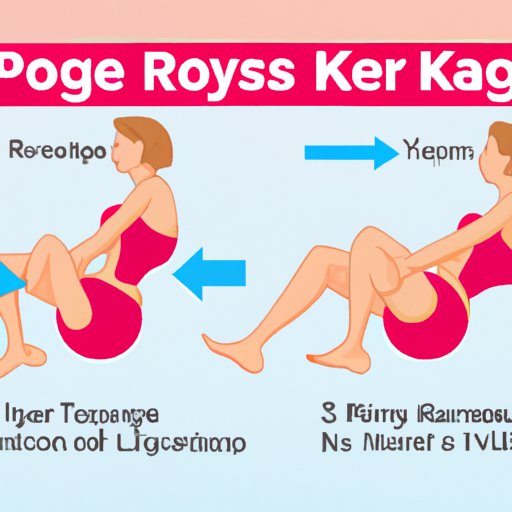Introduction
Kegel exercises are simple, yet effective exercises designed to strengthen the pelvic floor muscles in women. These exercises were developed by Dr. Arnold Kegel in the 1940s and are now widely recommended by doctors and physical therapists as a means of improving women’s health. Kegel exercises can help with urinary incontinence, reduce the risk of pelvic organ prolapse, and even improve sexual satisfaction.
Beginner’s Guide to Kegel Exercises
The first step to doing Kegel exercises is locating your pelvic floor muscles. To do this, you can try stopping and starting your urine stream while you’re urinating. The muscles that you use to do this are the ones you need to contract when doing Kegel exercises. Once you’ve located your pelvic floor muscles, you’re ready to begin your Kegel exercises.
There are several different types of Kegel exercises you can do. The most common type of exercise involves contracting and releasing your pelvic floor muscles in quick succession. This can be done for 10-20 seconds at a time, and repeated 3-4 times in a row. You can also do “long holds” where you contract your pelvic floor muscles and hold them for 10-15 seconds before releasing. Finally, you can do “quick flicks” which involve quickly contracting and releasing your pelvic floor muscles multiple times in a row.
Incorporating Kegel Exercises into Your Daily Routine
Once you’ve mastered the basics of Kegel exercises, it’s time to start incorporating them into your daily routine. Here are some tips to make sure you’re getting the most out of your Kegel exercises:
- Relax your pelvic floor muscles before each exercise session.
- Focus on contracting and relaxing your pelvic floor muscles without tensing other muscles in your body.
- Do Kegel exercises every day, or at least several times per week.
- Try to gradually increase the duration and intensity of your Kegel exercises over time.
It’s also helpful to set up a schedule for doing Kegel exercises. For example, you could do them twice a day, once in the morning and once in the evening. Or you could do them three times a day, before breakfast, lunch, and dinner. Whatever works best for you!
Science Behind Kegel Exercises and Women’s Health
Kegel exercises work by strengthening the pelvic floor muscles, which are responsible for supporting the bladder, uterus, and rectum. When these muscles become weak, they can cause a variety of health problems, including urinary and fecal incontinence, pelvic organ prolapse, and sexual dysfunction. By doing Kegel exercises, you can strengthen these muscles and reduce your risk of these conditions.
According to a study published in the International Urogynecology Journal, Kegel exercises can also improve sexual satisfaction. In the study, women who did Kegel exercises reported increased arousal, lubrication, orgasm, and overall satisfaction during sexual activity. In addition, the study found that Kegel exercises helped reduce symptoms of urinary incontinence.

Common Misconceptions About Kegel Exercises for Women
Despite their numerous benefits, there are still some common misconceptions about Kegel exercises for women. Here are two of the most common myths:
Myth 1: Kegel Exercises are Only for Women Who Have Had Children
This is false. Kegel exercises can be beneficial for women of all ages and stages of life, whether they have had children or not. In fact, it’s important for women to start doing Kegel exercises early in life in order to prevent pelvic floor muscle weakness later on.
Myth 2: Kegel Exercises Will Make You Look Better
This is also false. While Kegel exercises can help improve the tone and strength of your pelvic floor muscles, they won’t make you look better or give you a “perfect” body. Kegel exercises are primarily meant to improve your health, not your appearance.
Conclusion
Kegel exercises are a great way for women to strengthen their pelvic floor muscles and improve their overall health. They can help with urinary incontinence, reduce the risk of pelvic organ prolapse, and even improve sexual satisfaction. To get the most out of Kegel exercises, it’s important to locate your pelvic floor muscles and practice regularly. With patience and dedication, you can reap the many benefits of Kegel exercises.
(Note: Is this article not meeting your expectations? Do you have knowledge or insights to share? Unlock new opportunities and expand your reach by joining our authors team. Click Registration to join us and share your expertise with our readers.)
